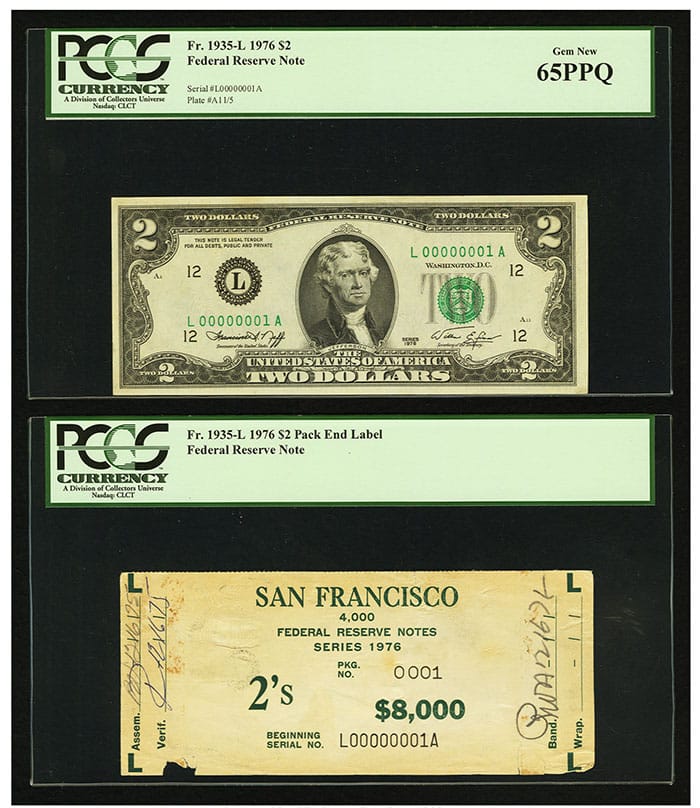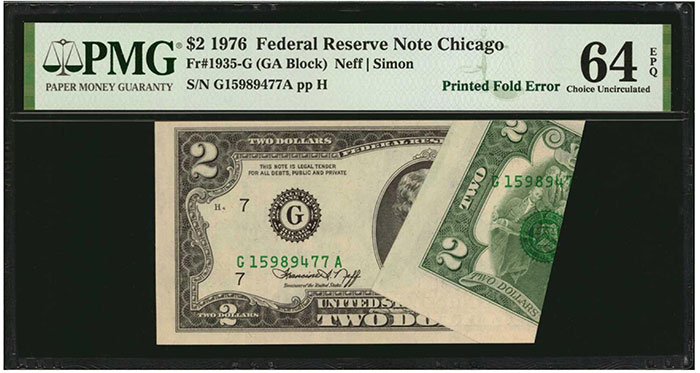
In the mid-1970s, various patriotic and numismatic items were released as the United States marked the bicentennial of its independence from Great Britain, one of the most significant of which was a new $2 bill: the Series 1976 $2 Federal Reserve Note. Sporting a design on the back that appears on the denomination to the present day, the Series 1976 was the first to bear that design and is generally accessible and affordable to paper money collectors.
History of the Bicentennial $2 Bill
Numerous numismatic products were issued marking the Bicentennial. A series of medals struck by the United States Mint was released beginning in 1972. In 1973, President Richard M. Nixon signed a bill authorizing commemorative designs on the quarter, the half dollar, and the dollar coin, along with a double date on those denominations struck in 1975 and 1976. And while it is getting harder, Bicentennial coinage can still be found in circulation today.
Another numismatic item commemorating the Bicentennial,though not as frequently found in circulation, the Series 1976 $2 FRN was approved in late 1975.
On November 3, 1975, Treasury Secretary William E. Simon announced that, in recognition of the United States Bicentennial, the Bureau of Engraving and Printing (BEP) would produce $2 Federal Reserve Notes, the first of their kind.

Though the new design for the $2 denomination was inspired by the Bicentennial, the Series 1976 $2 FRN was not a commemorative issue. The New York Times made explicit the connection between the new $2 bills and the Bicentennial in its November 9, 1975 coverage:
“[T]he bill is not a ‘special’ Bicentennial‐year issue; it will continue on as a permanent part of the nation’s circulating paper currency.”
The new notes were the first FRNs of the denomination; the last $2 notes issued, in the 1960s, were Legal Tender Notes with a red Treasury Seal and serial numbers. $2 Legal Tender Notes, National Bank Notes, Silver Certificates, Treasury Notes, and Federal Reserve Bank Notes had all been issued since the 1860s.
The face design remained largely unchanged, except the Treasury Seal and serial numbers, which on the $2 FRN is green.
The back design changed completely, with Thomas Jefferson’s mansion Monticello replaced by a depiction of John Trumbull’s painting entitled Declaration of Independence (1817). It was executed for the notes by Peter Cocci, a BEP staffer. The Bicentennial issue was not the first outing of Trumbull’s painting on U.S. paper money, of course; it first appeared on the back of $100 National Bank Notes in 1863, the year after the first federal $2 notes were introduced. The denomination appears in numerals in each corner, with scrolls featuring the written denomination flanking the bottom two numbers; the written denomination also appears vertically on either side of the Trumbull vignette.
Trumbull’s painting also appeared on one of the series of commemorative stamps issued for the Bicentennial, split into four sections; each of the four stamps in the series bore a quarter of the painting.
A total of 590,720,000 Series 1976 Bicentennial $2 bills were printed and the production run ended in 1978. All of the notes produced bear the signatures of Treasury Secretary Simon and Treasurer Francine Irving Neff.
The scarcest Star note for the series is the Friedberg-1935-J*. The issue’s Minneapolis Star notes are comparably rare.
The notes were released on April 13, 1976, Thomas Jefferson’s birthday.
Collectability of the Series 1976 $2 Note

Some observers were hopeful that the $2 denomination would be accepted in commerce, possibly reducing demand for $1 FRNs. An April 11, 1976, New York Times article claimed that:
“The new $2 note is expected to replace about one‐half of the $1 bills in circulation over the next several years. This will result in an estimated saving of $4 million to $7 million per year in printing costs.”
Nevertheless, the notes did not circulate widely, whatever the hopes of their proponents. The denomination is so uncommon in some areas that people have been arrested for trying to spend $2 notes at retail establishments. Yet the vast majority of Series 1976 $2 bills are abundant and affordable.
An interesting notaphilic and philatelic product was created around the Series 1976 $2 Federal Reserve Note release. Many people took the bills to post offices on the release day, affixed stamps directly to the notes, and had the stamps canceled at their local post office. Numerous series of commemorative stamps were issued marking the bicentennial, which made for thematically fitting note-stamp pairings. The stamped notes are not worth much beyond their face value, but a collector might seek out a note from their hometown or another location of personal significance.
Art Friedberg, the co-author of Paper Money of the United States (21st Ed., 2017), shares that the stamped Series 1976 $2 FRN sold briskly around the time of the Bicentennial.
“It was different, it was collectible, people loved it. We made a lot of money,” Friedberg explained in a phone interview.

Robert Azpiazu, owner of First City Coins and Collectibles and author of Collector’s Guide to Modern Federal Reserve Notes Series 1963-2009 (2011), elaborates on the stamped notes’ appeal in an email interview:
“There are some cancellations that are very valuable but only to a small group of eclectic collectors.”
Series 1976 Bicentennial $2 bills appear in a number of U.S. Mint products, including the 1994 Thomas Jefferson 250th Anniversary Coinage and Currency set, notable for its Satin Finish Jefferson nickel.
At the time of writing, Paper Money Guaranty (PMG) reports 18,462 total grading events for Series 1976 Bicentennial $2 bills from all 12 Federal Reserve banks; 5,538 of those are Star notes.
Circulated examples of Series 1976 $2 FRNs can be bought for around face value or occasionally found in circulation. Uncirculated examples can bring a dollar or two over face.

Rarer Star notes naturally command higher premiums, as do notes at the highest end of the condition scale or those with collectable serial numbers. F-1935-L with serial number 1 sold with its brick label in a Heritage auction on January 8, 2016, for $21,150 USD.
Issued in massive numbers with a design commemorating the U.S. Bicentennial, Series 1976 $2 Federal Reserve Notes are affordable and abundant, notable as the first $2 FRNs and for the numerous stamped specimens available for a little over their face value.
* * *
The post The Bicentennial $2 Bill – First of a Kind appeared first on CoinWeek: Rare Coin, Currency, and Bullion News for Collectors.
